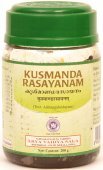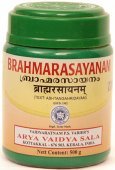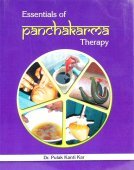Sarpis, Sarpī, Sārpi, Sarpi, Sarpish: 25 definitions
Introduction:
Sarpis means something in Buddhism, Pali, Hinduism, Sanskrit, biology. If you want to know the exact meaning, history, etymology or English translation of this term then check out the descriptions on this page. Add your comment or reference to a book if you want to contribute to this summary article.
In Hinduism
Purana and Itihasa (epic history)
Source: archive.org: The Garuda puranamA small medicinal shrub.
Source: archive.org: Shiva Purana - English TranslationSarpis (सर्पिस्) refers to “ghee”, according to the Śivapurāṇa 2.3.54 (“Description of the duties of the chaste wife”).—Accordingly, as a Brahmin lady said to Pārvatī: “[...] A chaste lady shall be delighted when her husband is delighted and dejected when he is dejected. She shall always wish for his benefit. She shall be virtuous and equanimous in affluence and adversity. She shall have fortitude and shall never go astray. Even when ghee (sarpis), salt, oil or other things are exhausted she shall not tell her husband openly about it lest he should be subjected to undue strain. [...]”.
Source: Cologne Digital Sanskrit Dictionaries: The Purana IndexSārpi (सार्पि).—A Bhārgava gotrakāra.*
- * Matsya-purāṇa 195. 23.

The Purana (पुराण, purāṇas) refers to Sanskrit literature preserving ancient India’s vast cultural history, including historical legends, religious ceremonies, various arts and sciences. The eighteen mahapuranas total over 400,000 shlokas (metrical couplets) and date to at least several centuries BCE.
Natyashastra (theatrics and dramaturgy)
Source: archive.org: The mirror of gesture (abhinaya-darpana)One of the Hands of the Seven Oceans.—Sarpi: the Catura hands moved upwards and downwards (vyāvṛttacāpaveṣṭitau). Note: Representing the up and down motion of waves.

Natyashastra (नाट्यशास्त्र, nāṭyaśāstra) refers to both the ancient Indian tradition (shastra) of performing arts, (natya—theatrics, drama, dance, music), as well as the name of a Sanskrit work dealing with these subjects. It also teaches the rules for composing Dramatic plays (nataka), construction and performance of Theater, and Poetic works (kavya).
Ayurveda (science of life)
Dietetics and Culinary Art (such as household cooking)
Source: Shodhganga: Dietetics and culinary art in ancient and medieval IndiaSarpi (सर्पि) refers to “ghee” and is mentioned in a list of potential causes for indigestion in the 17th century Bhojanakutūhala (dravyaguṇāguṇa-kathana), and is commonly found in literature dealing with the topics of dietetics and culinary art, also known as Pākaśāstra or Pākakalā.—A complete section in Bhojanakutūhala is devoted for the description of agents that cause indigestion [viz., sarpis (ghee)]. These agents consumed on a large scale can cause indigestion for certain people. The remedies [viz., nimbūphala (lemon) or yavoṣaṇa takra (buttermilk)] for these types of indigestions are also explained therewith.
Sarpis (ghee) is also mentioned as a remedy for indigestion caused by mocāphala (banana).
Toxicology (Study and Treatment of poison)
Source: Shodhganga: Kasyapa Samhita—Text on Visha ChikitsaSarpis (सर्पिस्) refers to “ghee” and is an ingredient which is included in a (snake) poison antidote recipe, according to the Kāśyapa Saṃhitā: an ancient Sanskrit text from the Pāñcarātra tradition dealing with both Tantra and Viṣacikitsā—an important topic from Āyurveda which deals with the study of Toxicology (Viṣavidyā or Sarpavidyā).—Several formulations have been mentioned in the form of Pāna—drink or decoction (kaṣāya).—In Kāśyapasaṃhitā (verse VIII.51), Kaśyapa prescribes a drink–‘hṛdayāvaraṇa’ (shielding the heart) prepared from cowdung and ghee (sarpis) which is very potent in saving a snake-bite victim. It is a well known fact that fresh cow-dung has anti-bacterial and anti-poisonous attributes
Agriculture (Krishi) and Vrikshayurveda (study of Plant life)
Source: Shodhganga: Drumavichitrikarnam—Plant mutagenesis in ancient IndiaSarpis (सर्पिस्) refers to “melted butter”, and is used in certain bio-organical recipes for plant mutagenesis, according to the Vṛkṣāyurveda by Sūrapāla (1000 CE): an encyclopedic work dealing with the study of trees and the principles of ancient Indian agriculture.—Accordingly, “If bulbs of various species of Nymphaea are uprooted tied together firmly with threads, smeared with melted butter (sarpis) and honey and then planted they produce those respective species in bunches (on a single creeper). Similarly several wonders of transformation can be worked out by tying together the stems of Nerium indicum and those of various species of Punica granatum”.
Unclassified Ayurveda definitions
Source: Wisdom Library: Āyurveda and botanySarpis (सर्पिस्) refers to “ghee” (ghṛta). It is used throughout Ayurvedic literature such as the Caraka-saṃhitā and the Suśruta-saṃhitā. It is obtained by churning the milk of a cow.
Source: gurumukhi.ru: Ayurveda glossary of termsSarpi (सर्पि):—Ghee; Synonym of Ghrita;

Āyurveda (आयुर्वेद, ayurveda) is a branch of Indian science dealing with medicine, herbalism, taxology, anatomy, surgery, alchemy and related topics. Traditional practice of Āyurveda in ancient India dates back to at least the first millenium BC. Literature is commonly written in Sanskrit using various poetic metres.
Dharmashastra (religious law)
Source: Sacred Texts: The Grihya Sutras, Part 2 (SBE30)Sarpis (सर्पिस्) refers to “melted butter”, according to the Āpastamba-yajña-paribhāṣā-sūtras.—“If it is said, juhoti, ‘he sacrifices’, it should be known that sarpir ājya, melted butter, is meant”. Commentary: “Sarpis is here taken as an adjective, running; yad asarpat tat sarpir abhavat”.

Dharmashastra (धर्मशास्त्र, dharmaśāstra) contains the instructions (shastra) regarding religious conduct of livelihood (dharma), ceremonies, jurisprudence (study of law) and more. It is categorized as smriti, an important and authoritative selection of books dealing with the Hindu lifestyle.
Jyotisha (astronomy and astrology)
Source: Google Books: Studies in the History of the Exact Sciences (Astronomy)Sarpis (सर्पिस्) refers to “ghee” and represents one of the items offered to the nine planets (navagraha), according to the grahaśānti (cf. grahayajña) section of the Yājñavalkyasmṛti (1.295-309), preceded by the section called vināyakakalpa (1.271-294), prescribing a rite to be offered to Vināyaka.—[verse 302-303: Faggots to be burned]—These two verses prescribe different faggots to be burned for grahas with offerings of honey, ghee [i.e., sarpis], dadhi, and milk. It is interesting to note that some of the faggots (i.e. parāśa, khadira, pippala, and śamī) mentioned here are also used in the Suśrutasaṃhitā in the context (Uttaratantra chapters 27-37) of curing the diseases caused by grahas, which, in this case, are not planetary. [verse 304-305: Cooked rice (odana) to be offered to grahas]

Jyotisha (ज्योतिष, jyotiṣa or jyotish) refers to ‘astronomy’ or “Vedic astrology” and represents the fifth of the six Vedangas (additional sciences to be studied along with the Vedas). Jyotisha concerns itself with the study and prediction of the movements of celestial bodies, in order to calculate the auspicious time for rituals and ceremonies.
Yoga (school of philosophy)
Source: ORA: Amanaska (king of all yogas): A Critical Edition and Annotated Translation by Jason BirchSarpis (सर्पिस्) refers to “ghee”, according to the Vivekamārtaṇḍa (verse 197-98).—Accordingly: “Just as [when] ghee has been poured into ghee, there is just ghee and [when] milk [has been poured] into milk [there is just milk], [so when] the Yogin [is absorbed in the highest reality,] there is just the highest reality. Like milk in milk, ghee in ghee (sarpis) and fire in fire, the Yogin who has dissolved into the highest state goes to absorption in it”.

Yoga is originally considered a branch of Hindu philosophy (astika), but both ancient and modern Yoga combine the physical, mental and spiritual. Yoga teaches various physical techniques also known as āsanas (postures), used for various purposes (eg., meditation, contemplation, relaxation).
General definition (in Hinduism)
Source: Wisdom Library: Hinduism1) Sarpi (सर्पि)—One of the eleven wives of Rudra, called a Rudrāṇī (Śrīmad Bhāgavatam 3.12.13).
2) Sarpi, name of an ocean surrouding the regions (dvipa) of the earth. (Brahma Purana, Vishnu Purana)
3) Sarpi can also mean clarified butter. (Vishnu Purana, Book II, Chapter II)
4) Sarpi: Sanskrit word for a (highly venomous female) snake. (Śrī Vidagdha-mādhava, Rāmāyaṇa)
Source: archive.org: Vedic index of Names and SubjectsSarpis (सर्पिस्) denotes ‘melted butter,’ whether in a liquid or solidified condition, and not differing from Ghṛta according to the St. Petersburg Dictionary. Roth there rejects the definition cited by Sāyaṇa in his commentary on the Aitareya-brāhmaṇa, which discriminates Sarpis as the liquid and Ghṛta as the solid condition of the butter. The word is repeatedly mentioned in the Rigveda and later.
In Buddhism
Tibetan Buddhism (Vajrayana or tantric Buddhism)
Source: OSU Press: Cakrasamvara SamadhiSarpi (सर्पि) refers to “ghee”, according to the purification (śodhana) of the Pañcagavya (five cow products) ritual often performed in combination with the Cakrasaṃvara Samādhi, which refers to the primary pūjā and sādhanā practice of Newah Mahāyāna-Vajrayāna Buddhists in Nepal.—Accordingly, “[...] Oṃ purified with conch-water Hūṃ. [Give water to patrons.] Cow urine, cow dung, milk, curd, ghee (sarpi), holy grass, (and) water, The forementioned Pañcagavya and holy grass purifies the body. Oṃ purified with conch-water Hūṃ. [Give water again]”.

Tibetan Buddhism includes schools such as Nyingma, Kadampa, Kagyu and Gelug. Their primary canon of literature is divided in two broad categories: The Kangyur, which consists of Buddha’s words, and the Tengyur, which includes commentaries from various sources. Esotericism and tantra techniques (vajrayāna) are collected indepently.
Biology (plants and animals)
Source: Google Books: CRC World Dictionary (Regional names)Sarpi in India is the name of a plant defined with Sansevieria roxburghiana in various botanical sources. This page contains potential references in Ayurveda, modern medicine, and other folk traditions or local practices It has the synonym Acyntha roxburghiana (Schult. & Schult.f.) Kuntze (among others).
Example references for further research on medicinal uses or toxicity (see latin names for full list):
· Enum. Philipp. Fl. Pl. (1923)
· Species Plantarum, ed. 4 (1799)
· Pl. Coromandel (1805)
· Systema Vegetabilium ed. 15 (1829)
· Revisio Generum Plantarum (1891)
If you are looking for specific details regarding Sarpi, for example pregnancy safety, chemical composition, diet and recipes, side effects, health benefits, extract dosage, have a look at these references.

This sections includes definitions from the five kingdoms of living things: Animals, Plants, Fungi, Protists and Monera. It will include both the official binomial nomenclature (scientific names usually in Latin) as well as regional spellings and variants.
Languages of India and abroad
Sanskrit dictionary
Source: DDSA: The practical Sanskrit-English dictionarySarpis (सर्पिस्).—n. [sṛp-isi Uṇādi-sūtra 2.17] Clarified butter; (for the difference between ghṛta and sarpis see ājya); यद्यप्यस्मिन् सर्पिर्वोदकं वा सिञ्चति वर्त्मनी एव यच्छति (yadyapyasmin sarpirvodakaṃ vā siñcati vartmanī eva yacchati) Ch. Up.4. 15.1.
Source: Cologne Digital Sanskrit Dictionaries: Shabda-Sagara Sanskrit-English DictionarySarpis (सर्पिस्).—n.
(-rpiḥ) Ghee, clarified butter. E. sṛp to flow, is Unadi aff.
Source: Cologne Digital Sanskrit Dictionaries: Benfey Sanskrit-English DictionarySarpis (सर्पिस्).—i. e. sṛp + is, n. Clarified butter, [Pañcatantra] iii. [distich] 27.
--- OR ---
Sārpī (सार्पी).—see the next.
Source: Cologne Digital Sanskrit Dictionaries: Cappeller Sanskrit-English DictionarySarpi (सर्पि).—[masculine] [Name] of a man.
--- OR ---
Sarpis (सर्पिस्).—[neuter] clarified butter, ghee ( = ghṛta).
--- OR ---
Sarpī (सर्पी).—[with] bhū become a serpent.
Source: Cologne Digital Sanskrit Dictionaries: Monier-Williams Sanskrit-English Dictionary1) Sarpī (सर्पी):—[from sarpa] a f. a female snake, [Mahābhārata]
2) [v.s. ...] Name of the wife of a Rudra, [ib.]
3) Sarpi (सर्पि):—[from sarpa] m. Name of a man, [Aitareya-brāhmaṇa]
4) [v.s. ...] n. (m.[case] for sarpis) clarified butter, [Varāha-mihira’s Yogayātrā]
5) Sarpiṣ (सर्पिष्):—[from sarpa] in [compound] for sarpis.
6) Sarpis (सर्पिस्):—[from sarpa] n. clarified butter (id est. melted butter with the scum cleared off, commonly called ‘ghee’, either fluid or solidified; also [plural]), [Ṛg-veda]; etc.
7) Sarpī (सर्पी):—[from sarpa] 1. sarpī f. See under sarpa.
8) [from sarpa] 2. sarpī in [compound] for sarpa. √
Source: Cologne Digital Sanskrit Dictionaries: Yates Sanskrit-English DictionarySarpis (सर्पिस्):—(rpiḥ) 5. n. Ghi.
Source: DDSA: Paia-sadda-mahannavo; a comprehensive Prakrit Hindi dictionary (S)Sarpis (सर्पिस्) in the Sanskrit language is related to the Prakrit word: Sappi.
[Sanskrit to German]
Sanskrit, also spelled संस्कृतम् (saṃskṛtam), is an ancient language of India commonly seen as the grandmother of the Indo-European language family (even English!). Closely allied with Prakrit and Pali, Sanskrit is more exhaustive in both grammar and terms and has the most extensive collection of literature in the world, greatly surpassing its sister-languages Greek and Latin.
Kannada-English dictionary
Source: Alar: Kannada-English corpusSarpi (ಸರ್ಪಿ):—[noun] clarified butter; ghee.
Kannada is a Dravidian language (as opposed to the Indo-European language family) mainly spoken in the southwestern region of India.
See also (Relevant definitions)
Starts with (+2): Sarpidvat, Sarpihsamudra, Sarpihsat, Sarpinmat, Sarpirasuti, Sarpisaro, Sarpisha, Sarpishka, Sarpishkundika, Sarpishmant, Sarpishmat, Sarpishpradyotika, Sarpishta, Sarpishvant, Sarpissamudra, Sarpissat, Sarpitkamya, Sarpitta, Sarpittama, Sarpittara.
Query error!
Full-text (+74): Samsarpin, Visarpin, Sarpihsamudra, Sarpishkundika, Sarpishmat, Sarpitta, Sarpittas, Sarpittva, Sarpittama, Sarpittara, Kshirasarpis, Vrikshasarpi, Sarpirasuti, Sarpibhu, Sarpih, Sarpisha, Kumbhasarpis, Sarpidvat, Sarpissamudra, Madhusarpis.
Relevant text
Search found 61 books and stories containing Sarpis, Sarpī, Sārpi, Sarpi, Sārpī, Sarpiṣ, Sarpish; (plurals include: Sarpises, Sarpīs, Sārpis, Sarpis, Sārpīs, Sarpiṣs, Sarpishes). You can also click to the full overview containing English textual excerpts. Below are direct links for the most relevant articles:
International Ayurvedic Medical Journal
Role of masanumasika pathya to prevent garbha shosha < [2021, Issue 9, September]
A book review on santāna chintāmani: comprehensive ayurve-dic health management of mother and child < [2024, Issue 01. January]
A case study to evaluate the efficacy of kal basti followed by panchatikta ksheer sarpi basti in the management of asthimajjagat vata with special reference to hla-b27 (ankylosing spondyliti < [2020, Issue 8, August]
Agni Purana (by N. Gangadharan)
Chapter 108 - Cosmographical account (bhuvana-koṣa)
World Journal of Pharmaceutical Research
Masanumasik paricharya of garbhini- a critical review < [2022: Volume 11, August issue 11]
Ghrita as vishghna and its yoga < [2021: Volume 10, February issue 2]
Role of Vrikshaamladi Churna and Madhuraamla in gudbhramsha management. < [2023: Volume 12, January issue 1]
Puranic encyclopaedia (by Vettam Mani)
Sushruta Samhita, Volume 6: Uttara-tantra (by Kaviraj Kunja Lal Bhishagratna)
Chapter LVIII - Symptoms and Treatment of suppression of Urine (Mutra-ghata) < [Canto III - Kaya-chikitsa-tantra (internal medicine)]
Chapter X - Treatment of Pittaja Ophthalmia < [Canto I - Shalakya-tantra (ears, eyes, nose, mouth and throat)]
Chapter XXI - Medical Treatment of Ear-disease < [Canto I - Shalakya-tantra (ears, eyes, nose, mouth and throat)]
Rig Veda (translation and commentary) (by H. H. Wilson)
Related products




